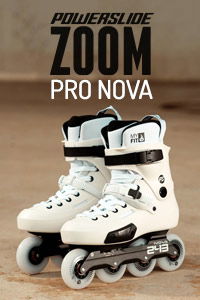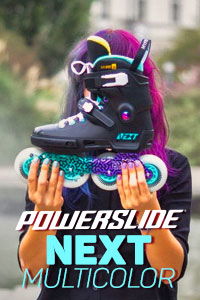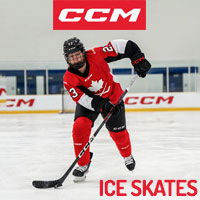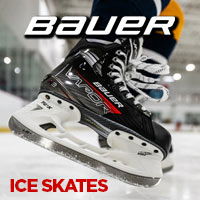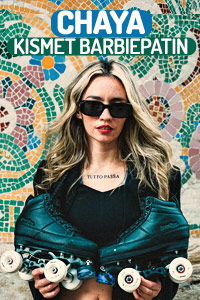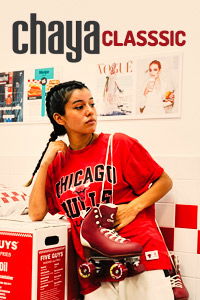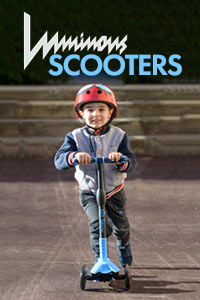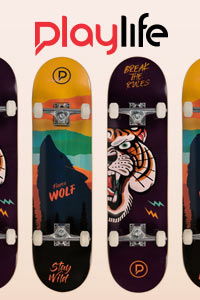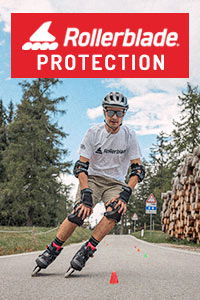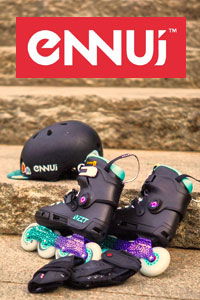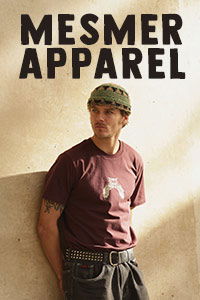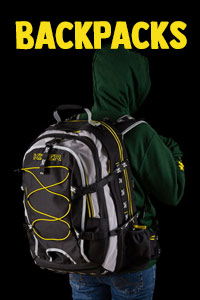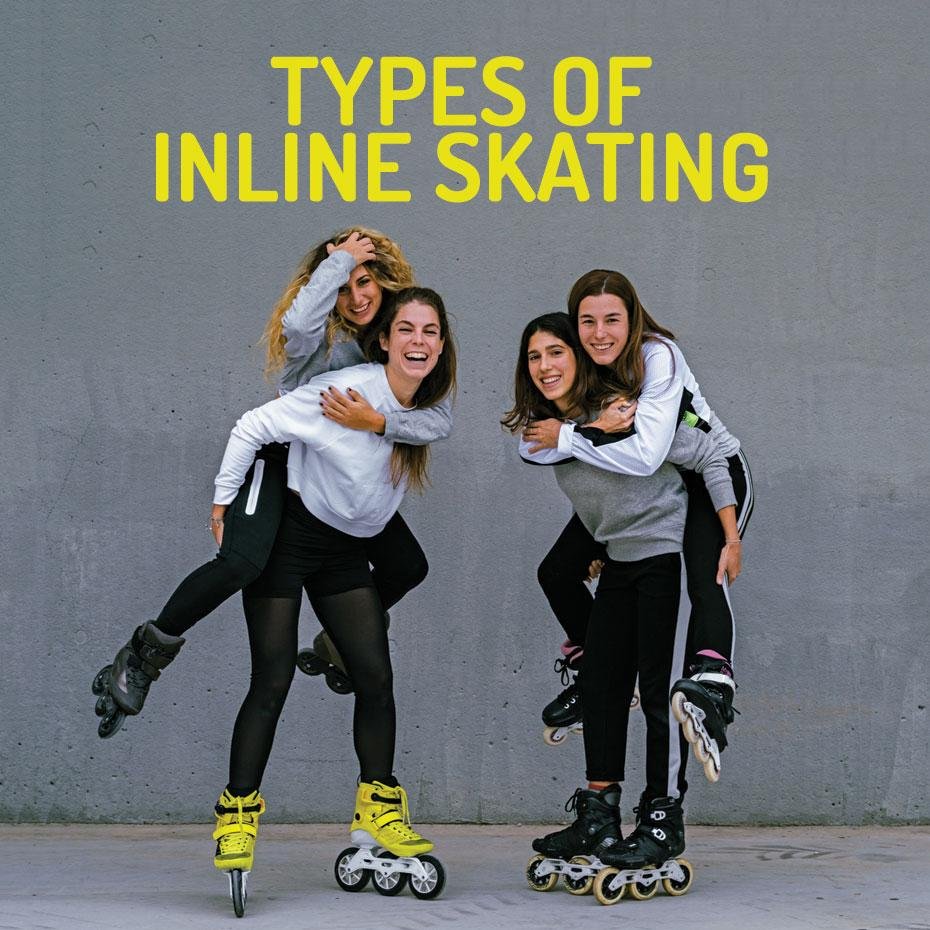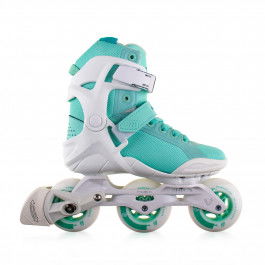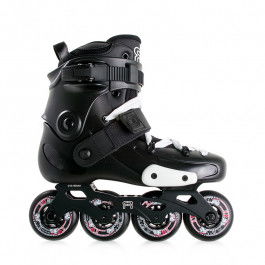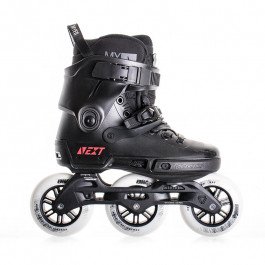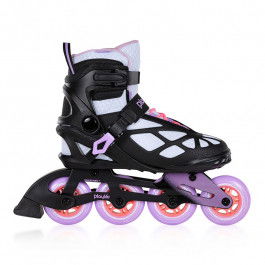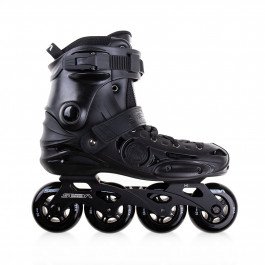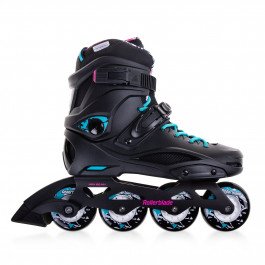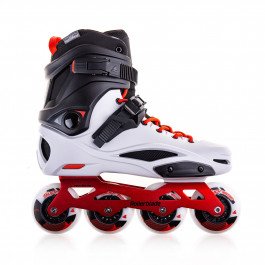Today, we present the first in a series of advisory articles on subject of choosing inline skates for yourself.
In this series, we will showcase why you should consider choosing a particular type of rollerblades and whether each type makes sense for an absolute beginner.
In this very first article, we will try to answer the basic question:
How to find out which skating style will appeal to us?
Every experienced person will tell you that the best way is to simply try rollerblading for yourself.
If you're not sure whether you'll love it and what opportunities it opens up for you, we recommend looking for a skating school in your area, one that also runs a rental service. Why?
Rentals often have proven models made by good, trustworthy brands. Of course, this is rarely a top-shelf equipment, but rather basic options that provide good ankle support and meet the requirements for taking the first steps in a world of skating. Additionally, the rental staff will help you choose the right size, which is very important.
A rollerblading school instructor will give you tips to make things easier. They will certainly also answer your questions, which can help define your needs when it comes to picking up proper skates for yourself. Because, there are really plenty of skill development directions!
Of course, you may have certain preferences right away. For example, you may have seen people doing tricks, whether in a skate park or between cones. Or skaters flowing through the city, performing jumps, slides and riding down the stairs? Or a passing marathon pack?
Another way is to think about what form of physical activity you like and what you value in it.
Maybe you are drawn to:
- Giving your body a proper workout, as during running.
- A sense of speed, as when cycling.
- A sense of lightness, like dancing gives you.
- Adrenaline rush from extreme sports.
There's a good chance that the type of rollerblading you are going to enjoy will be related to the above factors. And that can help you choose your pair of skates!
A brief overview of rollerblading styles (and skates themselves).
Below you'll find a list of the most important types of inline skating. We will dedicate a separate article to each of them in the future – that's why we won't go into too much detail today. Because not all of these disciplines can be taken up right away, we've divided them into two categories.
The first of them contains disciplines and skates that make sense for a complete beginner – that is, someone who has never skated, wants to start and will have to learn from scratch. Such equipment has a boot and an undercarriage (a frame and wheels) that should not cause you any trouble while acquiring skills.
In the second section, we will cover types of skating and skates for which you already need experience and technique. This is because these skates make it difficult, and sometimes even impossible, to learn from scratch.
Part one: rollerblades worth starting on.
Recreational and fitness skates – for fun, but also for fitness.
If you're looking for a pair of skates that will allow you a to go out several times per season for calm rides with friends, aim for recreational type. You can also choose them as the equipment to start your rollerblading adventure, but you need to be aware that they have their limitations and won't allow you to spread your wings, trying other disciplines.
Recreational skates are focused on maximum comfort, with performance taking a back seat.
They are usually the cheapest, entry-level models in manufacturers' collections. Comfortable and lightweight boots dominate here. They have soft wheels in sizes (most often) up to 80 mm, and their frames are often made of plastic.
Because of this, they are not really suitable for development in any other direction – unless we're talking about fitness rollerblading, which focuses on aerobic training. In this case, however, they will wear out quite quickly, not to mention that you have to buy higher-class wheels, a set of which may exceed the price of the recreational skates themselves.
Therefore, if you plan to approach rollerblading as a regular physical activity, it is better to go for the more expensive options in the fitness category.
Fitness rollerblading is a great sport for (obviously) staying fit and shaping your lower body parts. It's a great alternative to running, as it puts much less strain on the joints – and it's also more fun!
Therefore, the boot of fitness models is more durable than in recreational skates – it provides much better ankle support and allows for a stronger push. You also get stiffer, aluminium frames and higher-class wheels which enhance this effect further. You can really go fast and cover long distances.
However, with everything comes a price – and we're not just talking about money. In fitness skates, the distance from the foot to the ground is greater than in recreational ones due to the larger size of the wheels. In addition, a more rigid frame transmits more vibrations.
Four-wheel frames on 90 mm wheels, popular in the best models in this category, are quite long, so at first, they are hard to turn on. In the case of three-wheel skates, the frame is shorter, but wheels with a diameter of 100 or 110 mm make whole skate even higher.
This makes fitness skates slightly more difficult to master for beginners. Still, they are perfectly suitable for learning to skate on.
If you want to include rollerblades in your training routine (e.g. instead of running), go on long rides, or simply have solid equipment that will last for years and don’t care about tricks, fitness skates are definitely a good pick.
Freeskating – freedom and versatility.
Freeride, also known as freeskating, is a style that gives freedom of movement in urban space. If you want to jump, ride down stairs, slide, or simply whiz through the streets, freeskating is for you.
Even if you don't fully utilize the capabilities of freeskates, they are still a good choice. Their excellent ankle support makes learning process much easier, which is especially helpful for people who do not regularly engage in other physical activity.
In addition, their sturdy construction means they will last for years even with a frequent use.
There's nothing stopping you from using them for calmer rides. You can also learn basics of riding in skatepark (ramps, profiles, boxes). If you choose a model with a four-wheel 80 mm frame, you can start freestyle slalom without any problems. Or play street hockey, where agility and strong construction come in handy.
Out of all gear types, freeskates give you the highest level of freedom – not only in terms of moving in urban space.
We can say this without a shadow of a doubt: if you're just starting, freeride models won't let you down in any aspect. They offer a wide range of wheel setups, allowing you to go for versatility (the mentioned 4x80 in a 243 mm frame) or immediate specialization (e.g. faster models on 3x110 mm wheels).
It's worth noting that skates of this kind often don't come with a brake, although there are exceptions where the manufacturer includes it in the box. For many other models, you can purchase a brake separately. However, the goal is usually to ride without it, using other braking techniques instead.
Freestyle slalom - for those who like to dance and work hard to achieve their goals.
Freestyle slalom is a relatively accessible style that allows for gradual skill development, rewarding hard work and hours put into training. It involves performing tricks (akin to figures in ice skating) between cones placed in a straight line, with even spacing between them.
This style also develops your body in ways that are useful in other types of skating - a sense of balance and motor skills, allowing you to "feel" the rollerblades better. Mastering basic slalom tricks is possible on many types of skates and pays off even in aggressive inline!
As mentioned earlier, you can start slalom successfully in freeride rollerblades, but there are quite a few models on the market specifically designed for it.
All models dedicated to freestyle slalom are based on a boot construction with an integrated liner and carbon base. These rollerblades are stiff, provide exceptionally good ankle support (the best of all), and hold the foot in place perfectly.
Freestyle slalom frames are almost always length-adjusted to the size of the foot to provide the best possible maneuverability while maintaining reasonable level of stability. All have the ability to raise the outer wheels by 2 mm or have this type of axle placing built-in. This gives us the so-called banana rocker, imitating the curvature of the blade in ice skates, which significantly supports maneuverability.
Is this equipment good to start with?
Freestyle slalom skates certainly require coming to terms with a period of discomfort until they adapt to the foot. Comfort takes a back seat and responsiveness and energy transfer are top priority. You also have to consider that the "banana" rocker is a more unstable wheel setup than flat, when all of them are at the same level.
Objectively speaking - yes, you can start with these skates from scratch, although it's best to do so under the watchful eye of an instructor.
Inline hockey skates - for players.
As the name suggests, these are skates designed for playing hockey. Their purchase makes the most sense if you belong to a hockey club or team, even an amateur one, and want to develop in this sport.
If you plan to play from time to time with friends on concrete, but just as an additional, fun focused, side-activity freeskates will work just as well, beating hockey ones with their versatility and comfort, not to mention a more affordable price. Decent pair of hardboot skates is way cheaper than a decent pair of roller hockey skates!
The construction of roller hockey boots is identical to that of hockey ice skates, except that sometimes they have ventilation holes. Naturally, the blade is replaced by a frame with wheels. These frames are short, often tilted forward, and have smaller wheels under the toes. This is all aimed at lowering the center of gravity and enforcing a more dynamic riding stance, increasing acceleration.
In theory - if you want to learn basics on such skates, it's definitely possible. However, if you have no intention of playing inline hockey later on, it's better to go for a different kind of rollerblades.
Reason is pretty simple – hockey boots are hyper-focused on energy transfer and lack any vibration damping features. Their wheels are relatively small and while stock ones are designed for giving you good level of grip, they don’t last long due to their softness. Replace them with something harder and longer lasting later on and you’ll certainly feel these vibrations in your joints – or maybe even teeth.
Therefore, they are not recommended for recreational, fitness, or urban riding. They can feel nice for some tricks on flat, smooth surfaces, though – but it’s better to go for carbon based freeskates instead, as they allow for swapping frames.
Part two – more demanding styles with more specialized equipment
Aggressive inline skates - for street tricks fans.
Are you drawn to doing tricks in the skate park? Do you like skateboarding, but the board itself doesn't speak to you? Do you want a taste of adrenaline? Choose aggressive inline skates!
Truth to be told, while we are placing them in “advanced” category, they are more of an in-between type of skates.
They are primarily used for performing jumps and tricks on ledges and rails. In essence, skating itself is merely an addition. The number of adaptations of hardware, geared towards all of this, makes them rather hard to start on.
There is absolutely no point in buying them if you are not interested in tricks. To put more pressure on this: the wheels here are basically a "vestigial organ" and mainly serve for approaching the obstacle and riding away after jumping off from it. You know, you can easily ride from spot to spot in freeskates – but aggressive skates are so bad for it, fans of this style quite often use cars or public transport to get from one place to another. Things fare better in skateparks with smooth surfaces, though.<
Aggressive inline skates are very slow compared to other types, even the most basic recreational ones. In addition, most models have an "antirocker" setup, in which only two wheels per skate make contact with the ground. This severely lowers maneuverability and makes learning to ride from scratch difficult. They have that “on rails” feel.
These skates also have a soulplate, which is a wide surface attached to the bottom of the boot, sitting between it and frame, allowing for grind tricks to be performed but also increasing the weight. It also causes a problem while riding - you can scratch the surface with it if you do not use the correct technique on turns. You have to work hard with the crossovers to avoid falling – especially seeing that wheels are so small and frames so low, the boot is very close to the ground.
There are positives, though. The above mentioned low distance off the ground gives you a lot more confidence at the beginning. As majority of these skates are made from plastic, with plastic soulplates and frames, they disperse a lot of vibrations. They are also very strong built.
Furthermore, if you buy a pair of such skates and it will turn out that tricks are not your thing, there’s a “way out” without necessity of buying whole new skates. Agressive inline models all use Universal Frame System (apart from very rare exceptions like USD Aeon) which is compatible with every UFS frame on the market. You can buy “big wheel”/freeskating frames and efficiently turn your skates into a (bit heavier) urban skating setup.
If you want to learn to ride from the ground up and choose an aggressive model, make sure to pick one in which four wheels (on each skate) touch the ground or the frame allows for such a setting.
A lot of skates are sold in anti-rocker setup for cost saving reasons, but setting them up with "flat" can make steep learning curve a a bit more gentle. If your skates come with antirocker configuration, you can get a set of 4 wheels alongside with bearings and spacers to make frames to have four down.
Just remember, stock wheels in lower priced models are quite often not that great – so if you pick a set of four decent ones, move them into outer positions, with factory mounted ones in the middle. This will increase their longevity.
Semi-race skate – go fast, train hard, ride a marathon.
This type is quite often called "marathon". In practice, these skates are a transition point between high-end fitness models and speedskates.
Semi-race models have a boot with a cuff that's as high as in other categories, or barely lower. However, the technology and size of the wheels are definitely closer to full-fledged speedskates. This combination gives you plenty of ankle support, meaning that muscles won’t tire as fast as in low-cut boots, while high-end technology and focus on performance provides excellent energy transfer needed for skating fast.
All skates of this type are one-piece boots, meaning pretty thin, rigid and integrated padding. As you may guess, they aren’t the most comfy boots out there.
Frames equipped in such rollerblades are a proper speed class, even if some are low end models. This means that you must cope with significant length, which is necessary for strong push. It's rare for them to be shorter, but even if they are, we're talking exclusively about three-wheel rollerblades.
Due to the length of the frames and the size of the wheels, semi-race skates are difficult for beginners to control.
Looking at things realistically, most beginners won't be able to handle them. Maybe if you are very good at ice skating and/or skiing, then you have a chance – but it is not guaranteed.
It's better to go for fitness skates first and only after a long time, when you have developed a good technique, reach for the higher shelf.
Speedskates - the fastest, the hardest to tame.
Speedskating is a beautiful sport, both in the road marathons and track races variants. It's something for determined, methodical people who constantly set new goals. Racing on skates can induce you with a great level of excitement.
However, this discipline requires a high level of physical fitness, and if you want to break your own barriers, also practicing another kind of sport. You need it to increase the strength of key muscle groups and the general efficiency of the respiratory and circulatory systems. Without it, you’ll hit a ceiling you wouldn’t be able to break through sooner or later.
Speedskates are not equipment aimed at people who intend to use it only a few times a season. One of the factors is a price.
Speedskates, much like marathon and freestyle slalom skates, use carbon base. However, they are usually made from top-tier materials in other areas too, as budget is not that important. Furthermore, their padding is thin to increase energy transfer. They are very often sold boots only, so you can choose the frames and wheels yourself - in practice, among enthusiasts, no one rides “factory” setups.
The most striking feature which distinguishes specialised speedskates from every other type is low-cut boot. Its’ edge end just above the ankle bones. Why such a design? To free the ankle joint as much as possible, which allows for better acceleration and more efficient use of the double-push technique, without which there is no point in thinking about professional racing.
Furthermore, the wheels used are of the largest sizes. The 100 mm is bare minimum here and in practice, used in 4x100 only by smaller posture, lightweight people with small boot size. Everyone else is riding on either 4x110 or 3x125.
Balancing on such big diameter wheels requires plenty of skill considering there’s basically no cuff support and long frames make things even worse.
Out of all skating styles, the “proper” speedskating is the most difficult to master. People who go for it need to have years of experience of skating in fitness and marathon models and be prepared to endure discomfort – even fully custom made boots cause it to some degree.
If you're just looking for your first pair of rollerblades, you simply aren't ready for speed skating and won't be for a long time.
Off-road skates - (only) for trips out of town.
Off-road rollerblading is the most niche variant of our favorite sport.
The equipment is based on freeskating boots, to which a strong frame for 125 mm or 150 mm wheels has been attached. The wheels are wider than those in normal skates and, as you can guess, they are pneumatic.
This makes these skates impractical for anything other than off-road riding, on unpaved paths, and for descents. They will also work on a pump track or potentially in a dirt park, but that's essentially the end of their applications.
Inflated wheels absorb too much energy during push, making off road setups exceptionally slow when riding on flat, especially hard, surfaces. This effect is exacerbated by the wide tread and the rubber itself, which provide high rolling resistance.
In addition, despite the sincere intentions of the manufacturers, the brakes available in this type of skates are not very practical. Therefore, a trip on a downhill bike trail can be quite risky, given that these are designed with a reliable speed control in mind, which bike’s disc brakes provide.
Furthermore, these skates have the tallest setup height out of all types. Certainly not easy to handle properly.
There are also nordic/rollerski skates which have super long frames and two pneumatic wheels – one at the back and other at the front of the boot. Their low center of gravity may be seen as advantage, but the length and nature of the frame mean that this equipment is essentially only for summer cross-country skiing training.
You can make experience a bit better by using poles.
But as a equipment to start learning on? We say a definite no.
Figurine inline skating – what it sounds like, but no need for ice.
This is again an example of "from ice to parquet". Most likely you know what figurine ice skating is about.
When it comes to skates, their boots are made almost identical to ice counterparts, although with less insulation.
The blade has been replaced with an unusual frame, where in place of the front wheel we have a rubber or urethane stopper - looking like a smaller wheel or exactly like a part found in roller skates. The stopper serves the role of the toe picks in an ice skate blade. As for wheels themselves, there can be three or four, and the axles are quite often placed in a slight arc.
This is not equipment made for recreation, and the best rollerblades in this category are made of natural leather, which significantly increases their price.
It’s simple – if you won’t train figurine skating, won’t go for this type of skates. Well, even if you are newcomer to skating and intend to learn this style without having experience on ice, do not buy them right away. Get yourself a supportive hardboot with short frame and learn basics, front to back and back to front transitions, 180 degree jumps, balancing on one leg, crossovers in both directions while skating front and back – there’s plenty of things you have to master.
Furthermore, figurine inline skates are made for indoor skating, on rinks. You’ll easily ruin them during falls on concrete and asphalt, during falls that inevitably will happen during learning process. Hardboots will take much more beating.
The End!
You can expect articles covering each style more in-depth. In addition, if some technical terms used here are unclear, we recommend checking our glossary.


